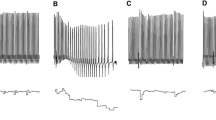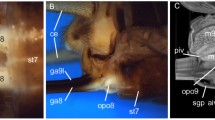Abstract
The decapod cardiovascular system consists of a single ventricle that pumps blood into seven arteries; previous work has shown that the outflow distribution patterns of intact animals are variable. In the present study, flow recordings were made from pairs of arteries in semi-isolated hearts whilst different cardioactive hormones were infused into the heart. Each hormone (5-hydroxytryptamine, octopamine, dopamine, proctolin and F1) changed the outflow pattern, heart rate and ventricular pressure in a unique way. The probable sites of hormone action are the cardioarterial valves located at the origin of each artery except one, the dorsal abdominal. Outflow from the dorsal abdominal is controlled downstream by valves located at the origin of the segmental lateral arteries. The responses to a particular hormone were sometimes different between the hearts of American and Japanese lobsters.
Similar content being viewed by others
Author information
Authors and Affiliations
Additional information
Accepted: 11 May 1998
Rights and permissions
About this article
Cite this article
Wilkens, J., Kuramoto, T. Comparison of the roles of neurohormones in the regulation of blood distribution from the hearts of American and Japanese lobsters. J Comp Physiol B 168, 483–490 (1998). https://doi.org/10.1007/s003600050168
Issue Date:
DOI: https://doi.org/10.1007/s003600050168




